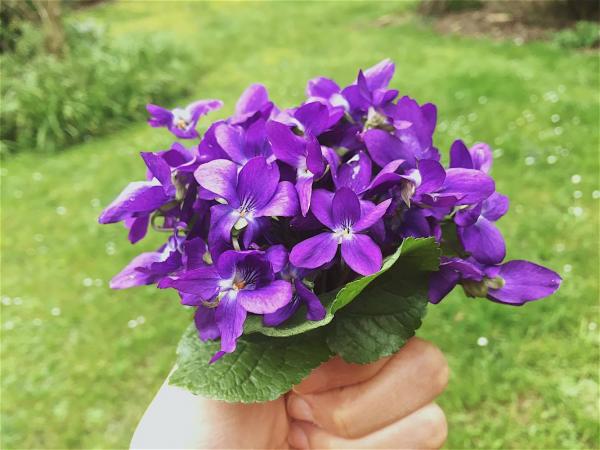A couple of years ago I was contacted by a woman whose father had a cancerous tumour. She was looking for a source of violet plants as she wanted to treat him with this age-old remedy. She planned to make a poultice every day from the leaves and flowers. Impressive stuff! and needless to say she was going to need a heck of a lot of violets. My garden is my treasure chest, so many humble little plants and often unwelcome weeds are the real stars when it comes to making natural medicines. The violet however never fails to attract my attention. When the sun warms the flowers, that divine scent is released. This for me is the sweet herald of spring and hope renewed.

Family; Violaceae
Common Names; Violet, sweet violet, common violet, garden violet, english violet.
Description; there are over 400 species of violets. The medicinal viola odorata is a small evergreen perennial plant with highly scented purple (sometimes white) flowers. The single flowers are situated at the end of long stalks that emerge alternately from the axils of the slightly downy heart-shaped leaves. Each nodding flower has 5 petals 2 of which grow vertically. The single flowers are produced twice a year in spring and again in autumn. The plants spread most easily from the roots as a creeping rhizome or underground stem. These are sent out in summer after flowering.
Parts used; flowers, leaves and root.
Preparations; teas/infusions/decoctions, tinctures/extracts, homeopathic remedies, creams/balms/ointments, poultices or washes, scented water, perfumes, essential oils, potpourri.
Habitat; the violet is native to Europe and Asia. Introduced throughout the temperate regions it has easily naturalised in gardens, forest edges, shaded lawns and under hedges. The plant succeeds in most soils, but prefers a cool, moist, well-drained and humus-rich soil in dappled shade.
Traditional & Historical Uses; the violet has been recorded as a medicinal herb since the time of Hippocrates. The Ancient Greeks and Romans made violet wine, and used the flowers to make perfumes and confections, extensively cultivating the flower for these purposes. The Ayurvedic and Unani systems of medicine include viola odorata and it’s use is recorded extensively in the materia medica of Arabic and Persian healing modalities. Used in the middle Ages by herbalists for cancer of the breast, lungs and digestive tract. The leaves as a poultice to shrink tumours and skin cancers as well as taken internally. A blood purifier and for treating congested neck lymph glands (applied as a salve and taken internally as a tea). Tuburculosis, whooping cough, bronchitis, rheumatism in the small joints( particularly those of the wrist), gout, insomnia, enuresis in children, headaches with dizziness. In syrups as a cough expectorant.
Therapeutic actions; expectorant, anti-tussive, anti-bacterial, anti-oxidant, anti-spasmodic, anti-inflammatory (flowers), analgesic, diaphoretic, mild laxative, diuretic (seeds), emetic (roots), purgative (roots & seeds), sedative, demulcent (flowers), emollient (flowers)
Constituents; Acids: ferulic acid, salicylic acid, sinapic acid, malic acid, octenoic acid, octylic acid, palmitic acid, propionic acid. Alkaloids: scopoletin, odoratine, violin. Flavonoids: quercetin, rutin. Saponins. Mucilages. Methyl salicylate. Vitamins C & A. Alcohols: eugenol, nonasdienol, octadienol, benzyl alcohol, beta sitosterol. Ketones: parmone.
Current Herbal uses. Externally; sores and ulcers, rashes and eczema, insect bites, varicose ulcers, chronic skin complaints, as a gargle for tonsilitis and sore throats. Internally; In respiratory disorders it is useful as an expectorant for coughs (make an infusion of the flowers) or in a cough syrup. In bronchitis (a decoction of the roots and or flowers) it helps to reduce inflammation, soothe coughing and expel secretions. Fever in influenza (tisane of flowers) can induce sweating and help reduce temperature. For asthma (tincture/ extract) helps reduce inflammation of the mucous membranes of the lungs and decrease coughing. In digestive disorders it’s used to soothe and reduce inflammation in gastritis (tea/tisane of flowers) and for gastric and stomach ulcers. For constipation the flowers (make a tea) are mildly laxative. Tisanes can be used in cystitis and nephritis. Of course most people will choose antibiotics as their first course of treatment but there is nothing to stop us from supporting and assisting the body to heal by using our own natural remedies as well.
Contra-indications; there are no known contra-indications just make sure to take care if using the roots. The saponins contained in the roots are powerful emetics. Too strong a decoction will induce vomiting.
Gardening applications; a welcome addition to any garden, they can be used as a groundcover under shrubs, trees and hedges.
Food uses; fresh flowers and young leaves can be added to salads, the leaves as a pot herb added to soups and stews. Flowers can be used in deserts and jellies, and are crystalized for decorationg cakes and confectionary.
Naturally by Trisha products containing violet ; Solar-x, Forever Face Cream
I Love violets so much, the scent, the colour, the beauty and now the beneficial wonders they bestow on us. Great information to add to an already useful flower.
This is very informative. I will be referring back to this. This spring I definitely want to try some of these remedies from my viola’s. Thank you for the great info!!!